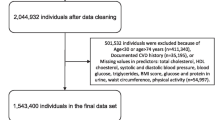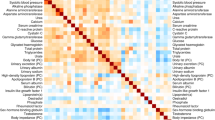Abstract
Exploratory data analysis (EDA) software facilitates unstructured, iterative open exploration of complex datasets with the aid of multiple linked graphical displays. We are investigating relationships between plasma lipoproteins and coronary artery disease by retrospective analysis of 1677 consecutive UCSF Lipid Clinic patients. Our preliminary experience is with Data Deck 3.0 although several additional software programs (JMP 2.0, Systat 5.1, Minitab 8.0, StatView 4.0) are mentioned. Lipid diagnosis (751 women and 925 men) was 22% primary hypercholesterolemia, 19% combined hyperlipidemia, 3% dysbetalipoproteinemia, 15% endogenous lipemia, 4% mixed lipemia, 5% elevated Lp(a) and 32% with no major lipid abnormality. We found the Macintosh platform (68030) to be flexible and powerful for analysis of moderate size (less than 1 Mb) clinical datasets. High resolution color monitors (1024 MX 768 pixels), fast hard disks (<18 msec) and moderate amounts of system memory (8 + Mb) facilitate exploratory analysis.
Similar content being viewed by others
References
Havel, R., Kotite, J., Kane, J., and Tun, P., Atypical familial dysbetalipoproteinemia associated with apolipoprotein phenotype E3/3.J Clin Invest. 72:379–387, 1983.
Hobbs, H.H., Leitersdorf, E., Leffert, C.C., Cryer, D.R., Brown, M.S., and Goldstein, J.L., Evidence for a dominant gene that suppresses hypercholesterolemia in a family with defective low density lipoprotein receptors.J Clin Invest. 84(2):656–64, 1989.
Asymptomatic hypercholesterolemia: a clinical policy review. The Toronto Working Group on Cholesterol Policy.J. Clin. Epidemiol. 43(10):1028–121, 1990.
Abbott, R., and Carroll, R., Interpreting multiple logistic regression coefficients in prospective observational studies.Am. J. Epidemiol. 119:830–6, 1984.
Eisenberg, S., Heiss, G., Friedlander, Y., Rifkind, B., Segal, P., Williams, O.D., and Stein, Y., Comparison of plasma lipids, lipoproteins and dyslipoproteinemia in Israel and the United States. The Lipid Research Clinics Program Prevalence Study.Atherosclerosis 59(1):63–74, 1986.
Ciampi, A., Schiffrin, A., Thiffault, J., and Quintal, H., Cluster analysis of an insulin dependent diabetes cohort towards the definition of clinical subtypesJ. Clin. Epidemiol. 43(7):701–715, 1990.
Loughlin, J., Leung, F., and Henderson, A., Classification of hyperlipoproteinemias by computer interpretation.Ann. Clin. Biochem. 21:326–331, 1984.
Rucker, D., Mavon, D., and Shortliffe, E., Temporal representation of clinical algorithms using expert system and database tools.Comp. Biomed. Res. Jun 23(3):222–239, 1990.
De, K.P., Stalenhoef, A.F., Mol, M.J., Gevers, L.J., Smits, J., Erkelens, D.W., Schouten, J., Frants, R.R., and Havekes, L.M., Influence of apo E polymorphism on the response to simvastatin treatment in patients with heterozygous familial hypercholesterolemia.Atherosclerosis 83(1):89–97, 1990.
Bhushan, V., Quantitative and qualitative relationships among VLDL in 1677 consecutive lipid clinic patients. Unpublished dissertation, University of California San Francisco, M.D. with thesis, May 1991.
Author information
Authors and Affiliations
Rights and permissions
About this article
Cite this article
Bhushan, V., Malloy, M.J., Engler, M.M. et al. Exploratory data analysis of hyperlipidemia on the Macintosh: Software tools for analysis of biochemical, clinical, and genetic variables in 1677 consecutive lipid clinic patients. J Med Syst 17, 187–193 (1993). https://doi.org/10.1007/BF00996944
Issue Date:
DOI: https://doi.org/10.1007/BF00996944




